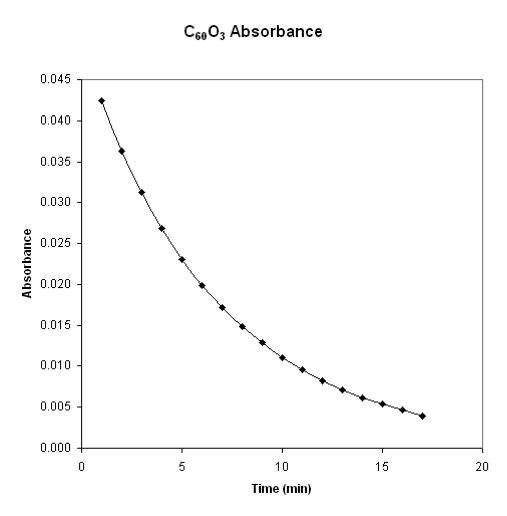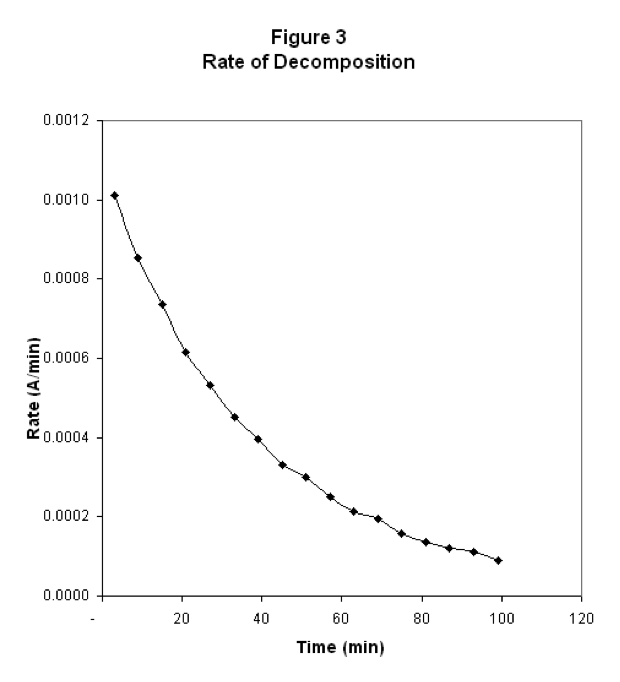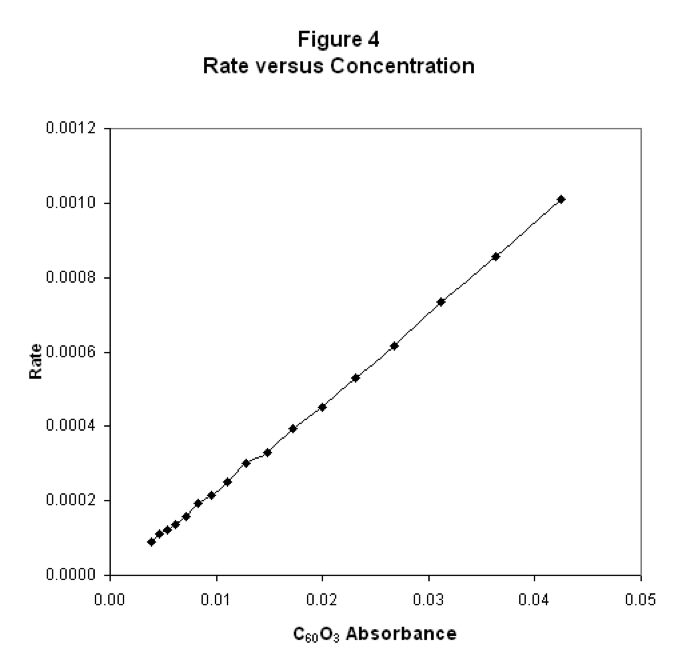| << Chapter < Page | Chapter >> Page > |
| time (min) | C 60 O 3 absorbance |
|---|---|
| 3 | 0.04241 |
| 9 | 0.03634 |
| 15 | 0.03121 |
| 21 | 0.02680 |
| 27 | 0.02311 |
| 33 | 0.01992 |
| 39 | 0.01721 |
| 45 | 0.01484 |
| 51 | 0.01286 |
| 57 | 0.01106 |
| 63 | 0.00955 |
| 69 | 0.00827 |
| 75 | 0.00710 |
| 81 | 0.00616 |
| 87 | 0.00534 |
| 93 | 0.00461 |
| 99 | 0.00395 |

The rate of the decomposition reaction is the same as the rate of change in [C 60 O 3 ], since the reaction reduces this concentration. The rate of change in the concentration is proportional to the slope of the graph in Figure 2. Therefore, we define the rate of this reaction as
Technically, we should take the derivative of the curve in Figure 2, since the graph is not a straight line, but we can make an excellent estimate by taking differences as shown in this equation. Notice we have added a negative sign to the rate of change of the concentration. This is because we want the rate of reaction to be positive, since the reaction is proceeding forward. However, we are measuring the rate of disappearance of the reactant in this case, which is a negative number. By including a negative sign in the definition of reaction rate in Equation (1), the rate is a positive number. The rate, calculated in this way, is plotted as a function of time in Figure 3.

Looking at Figure 2, we see that the slope of the graph changes over the course of time. We should not be surprised then that Figure 3 shows that the rate of the reaction decreases as the reaction proceeds. The reaction is at first very fast but then slows considerably as the reactant C 60 O 3 is depleted.
The shape of the graph for rate versus time (Figure 3) is very similar to the shape of the graph for concentration versus time (Figure 2). This suggests that the rate of the reaction is related to the concentration of C 60 O 3 at each time. Therefore, in Figure 4, we plot the rate of the reaction, defined in Equation (1) and shown in Figure 3, versus the absorbance of the C 60 O 3 .

We find that there is a very simple proportional relationship between the rate of the reaction and the concentration of the reactant. Therefore, we can write
where k is a proportionality constant. This equation shows that, early in the reaction when [C 60 O 3 ] is large, the reaction proceeds rapidly. As C 60 O 3 is consumed, the reaction slows down. Equation (2) is an example of a “rate law,” expressing the relationship between the rate of a reaction and the concentrations of the reactant or reactants. Rate laws are expressions of the relationship between experimentally observed rates and concentrations.
As a second example of a reaction rate, we consider the “dimerization reaction” of butadiene gas, CH 2 =CH-CH=CH 2 . Two butadiene molecules can combine to form vinylcyclohexene, shown in Figure 5.

Table 2 provides experimental data on the gas phase concentration of butadiene [C 4 H 6 ] as a function of time at T = 250 ºC.
We can estimate the rate of reaction at each time step as in Equation (1), and these data are presented in Table 2 as well. Again we see that the rate of reaction decreases as the concentration of butadiene decreases. This suggests that the rate is given by an expression like Equation (2). To test this, we calculate Rate /[C 4 H 6 ] in Table 2 for each time step. We note that this is not a constant, so the relationship in Equation (2) does not describe the relationship between the rate of reaction and the concentration of butadiene. We can try a variety of different functions to find one which does describe the data. In Table 2, we calculate Rate /[C 4 H 6 ] 2 to see if the relationship is an inverse square. We discover that this ratio is a constant throughout the reaction.

Notification Switch
Would you like to follow the 'Concept development studies in chemistry 2013' conversation and receive update notifications?